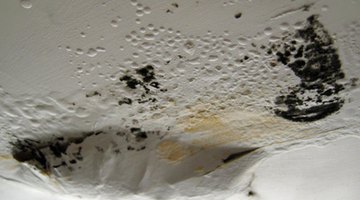How to Remove Mold From a Plaster Ceiling
Mold in your home can trigger allergies and other respiratory problems. It can even cause very serious illness, in the case of mycotoxins, warns the Environmental Protection Agency (EPA). Even small amounts of mold, such as a corner of a plaster ceiling, indicate a moisture problem.

This moisture can result from a poorly ventilated, humid bathroom or perhaps a leaky roof. Once you've addressed the root cause of your plaster ceiling mold, the unsightly black stains should be cleaned.
Things You Will Need
- Bleach
- Paper towels
- Rags
- Spray bottle
- Detergent
- Gloves
- Eye protection
Tip
Bleach cleans mold and makes it disappear, but it will not kill mold, especially on a porous surface like plaster. If the mold on your ceiling is extensive, or if you have dampness and mold in other parts of your home, call a mold remediation professional.
Warning
If you don't remedy the humid or wet conditions that made the mold grow in the first place, it will simply grow back. Wear gloves when using bleach, and remove or cover anything that could be discolored by bleach from the work area. Bleach is corrosive to skin. Never mix bleach with detergents or other cleaners. The resulting fumes are dangerous.
-
Test to see if the stain is actually from mold, not dirt or water. Spray or dab a little bleach on the moldy area. If the color fades and disappears within a minute, it's mold. If the bleach doesn't make the stain disappear, it's not mold.
-
Scrub away loose mold with paper towels Wipe only the moldy area, then discard the paper towels in the trash. Don't use them to wipe anywhere else because you'll spread mold spores.
-
Mix four parts bleach to one part water. Spray or sponge the solution liberally on the moldy ceiling. Wear eye protection to keep bleach out of your eyes. Let the solution sit on the surface for 10 to 15 minutes.
-
Rinse the bleach solution well, and let the ceiling dry. Bleach typically does not harm plaster or painted walls.
-
If you don't have bleach, use household detergent and water. The EPA recommends scrubbing the mold from hard surfaces with detergent and water, then rinsing it.
-
Throw away all the rags you've used for the project.
The Drip Cap
- Mold in your home can trigger allergies and other respiratory problems.
- Spray or dab a little bleach on the moldy area.
- If the bleach doesn't make the stain disappear, it's not mold.
- Let the solution sit on the surface for 10 to 15 minutes.
- Bleach typically does not harm plaster or painted walls.
References
Writer Bio
Stevie Donald has been an online writer since 2004, producing articles for numerous websites and magazines. Her writing chops include three books on dog care and training, one of which won a prestigious national award in 2003. Donald has also been a painting contractor since 1979, painting interiors and exteriors.
Photo Credits
- leaky ceiling 1 image by askthegeek from Fotolia.com
- leaky ceiling 1 image by askthegeek from Fotolia.com
More Articles



